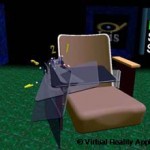Overview
Isis is a virtual reality program written to assist in the design of spherical mechanisms. It is written in C++ using WorldToolKit on the SGI platform. Solutions are calculated in the design process using code from Sphinx, a
workstation-based spherical mechanism design tool. Interaction with the program takes place through a combination of gestures with Fakespace Pinch Gloves and picks from 3-D menus. The program may be used on a standard monitor, in an n-Vision HMD, and in Iowa State University’s C2 environment.
To design a mechanism, the user moves geometry to the desired positions in space. The sphere is constrained as these positions are chosen. Next the order in which the mechanism should travel through the positions is chosen. After this, possible fixed and moving pivot locations, or “cones”, may be generated. Two axes are then chosen from the cones to generate a spherical fourbar mechanism that is expected to perform the desired task. As an alternative to the cones, a type map may be created to guide the creation of a mechanism. A type map is a 2-D plot of all the possible mechanisms color coded by mechanism type. Filters applied to the type map remove defective mechanisms from the display, and choosing one point on the map generates a mechanism of the indicated type.
To verify that the mechanism will work as expected, the user can animate it as shown in the above picture. If necessary, design iterations may be performed to achieve a better mechanism. Users can try different mechanisms for the same four positions, or they can move the design positions and create a new mechanism.
A unique feature of the program is the “design in context” approach synthesis. The chair and tray above are examples of this. Users design mechanisms using geometry that depicts the intended application of the mechanism instead of working only with coordinate frames as in previous spherical mechanism design software.
This project is being conducted in collaboration with Dr. Pierre Larochelle of the Florida Institute of Technology and J. Michael McCarthy of the University of California, Irvine.
Images
- Another example of design in context – Soda can task (24K)
- Interaction with the type map – Type Map (25K)
- Choosing the cones – Cones (10K)
- An example of an Isis menu – Main Menu (22K)
- Diagram of mechanism’s axes- Diagram (46K)
- Physical can-moving mechanism- Mechanism (32K)
Animations
- Menus (Quicktime movie, 4.4 MB)
- Mechanism Animation (Quicktime movie, 3.2 MB)
Publications
- Evans, Paul T., Vance, Judy M., Dark, Veronica J., “Assessing the Effectiveness of Traditional and Virtual Reality Interfaces in Spherical Mechanism Design” ASME Journal of Mechanical Design, Vol. 121, No. 4, December 1999 pp. 507-514
- Furlong, Todd J., Vance, Judy M., Larochelle, Pierre M., “Spherical Mechanism Synthesis in Virtual Reality,” 1998 ASME Design Automation Conference Proceedings, Atlanta, GA, Sept. 1998.
ASME Journal of Mechanical Design, Vol. 121, No. 4, December 1999, pp. 507-514 - Larochelle, Pierre, Vance, Judy M., McCarthy, J. Michael, “A Virtual Reality Environment for Spherical Mechanism Design” 1997 National Science Foundation Design and Manufacturing Grantees Conference Proceedings, Seattle, Washington, January 7-10, 1997, pp. 85-86.
- Furlong, T., Spherical mechanism design in virtual reality, M.S. Thesis, Iowa State University, 1998
Personnel
- Dr. Judy M. Vance, Principal Investigator
- Dr. Pierre Larochelle, Florida Institute of Technology
- J. Michael McCarthy, University of California, Irvine
- Todd J. Furlong, Graduate Research Assistant
Funding
- National Science Foundation – Grant Number: DMI-9612062: A Virtual Reality Environment for Spherical Mechanism Design
Facilities
For more information, see: A Virtual Reality Environment for Spherical Mechanism Design
